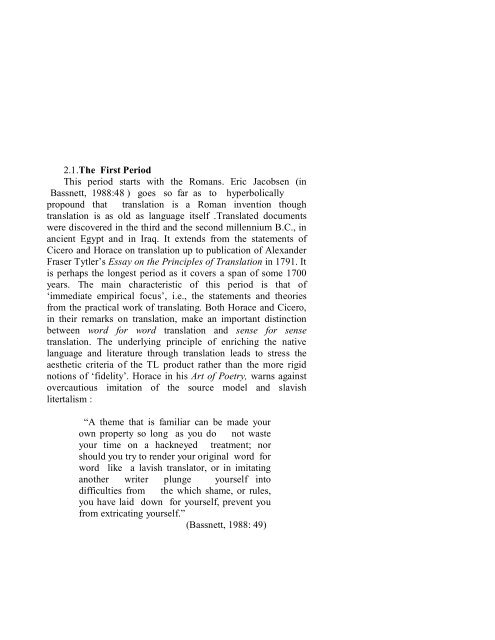424_2061_A.B.
424_2061_A.B.
424_2061_A.B.
- No tags were found...
Create successful ePaper yourself
Turn your PDF publications into a flip-book with our unique Google optimized e-Paper software.
2.1.The First PeriodThis period starts with the Romans. Eric Jacobsen (inBassnett, 1988:48 ) goes so far as to hyperbolicallypropound that translation is a Roman invention thoughtranslation is as old as language itself .Translated documentswere discovered in the third and the second millennium B.C., inancient Egypt and in Iraq. It extends from the statements ofCicero and Horace on translation up to publication of AlexanderFraser Tytler’s Essay on the Principles of Translation in 1791. Itis perhaps the longest period as it covers a span of some 1700years. The main characteristic of this period is that of‘immediate empirical focus’, i.e., the statements and theoriesfrom the practical work of translating. Both Horace and Cicero,in their remarks on translation, make an important distinctionbetween word for word translation and sense for sensetranslation. The underlying principle of enriching the nativelanguage and literature through translation leads to stress theaesthetic criteria of the TL product rather than the more rigidnotions of ‘fidelity’. Horace in his Art of Poetry, warns againstovercautious imitation of the source model and slavishlitertalism :“A theme that is familiar can be made yourown property so long as you do not wasteyour time on a hackneyed treatment; norshould you try to render your original word forword like a lavish translator, or in imitatinganother writer plunge yourself intodifficulties from the which shame, or rules,you have laid down for yourself, prevent youfrom extricating yourself.”(Bassnett, 1988: 49)21
















